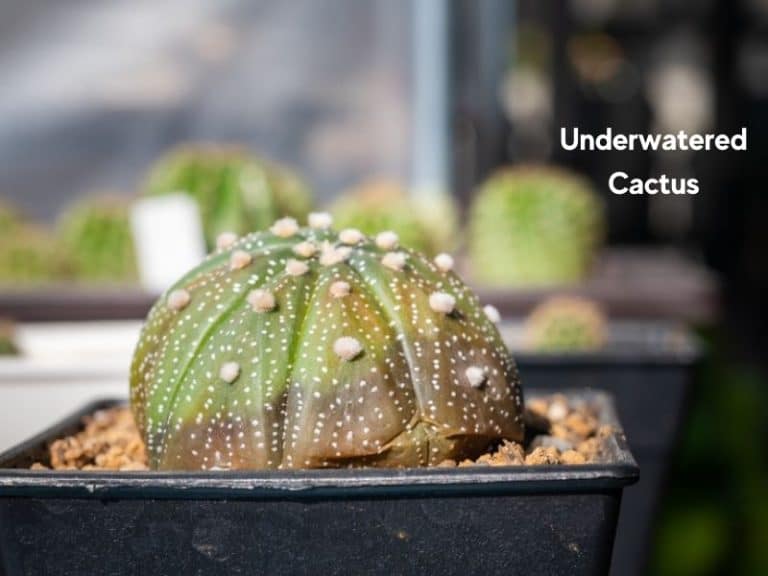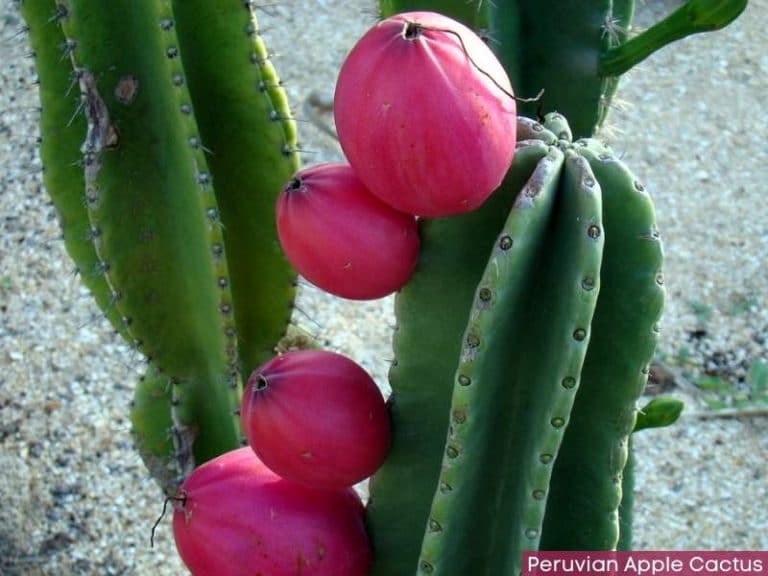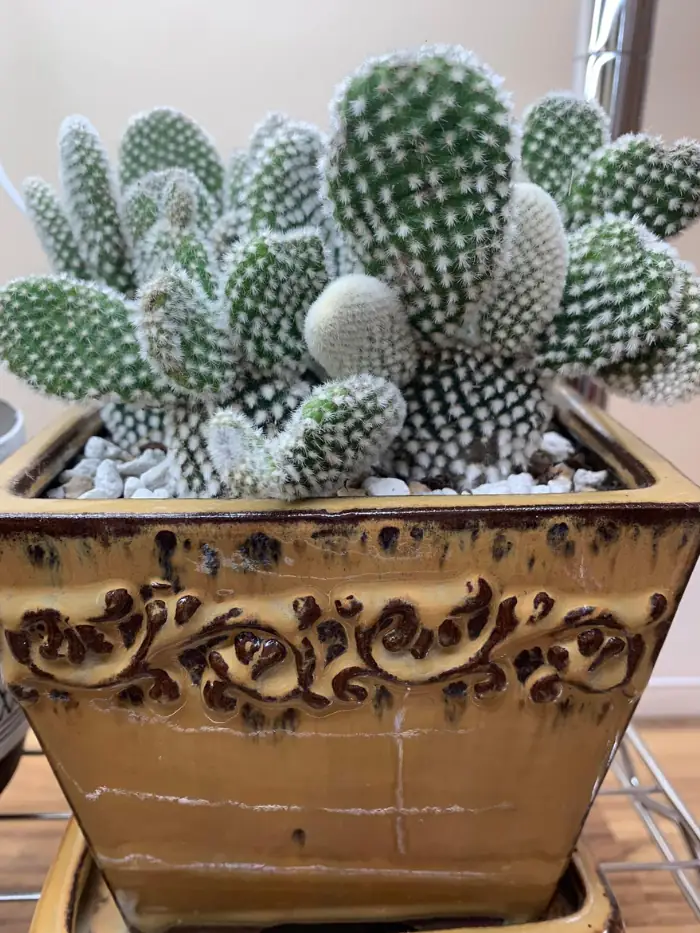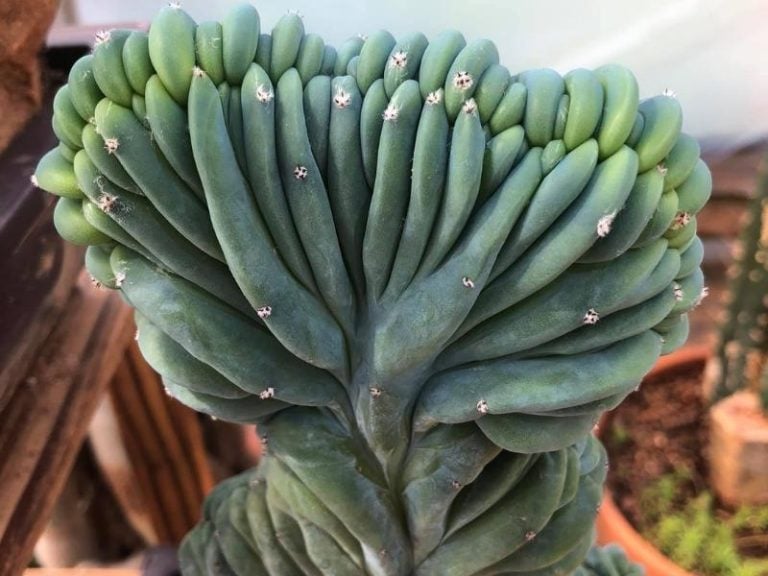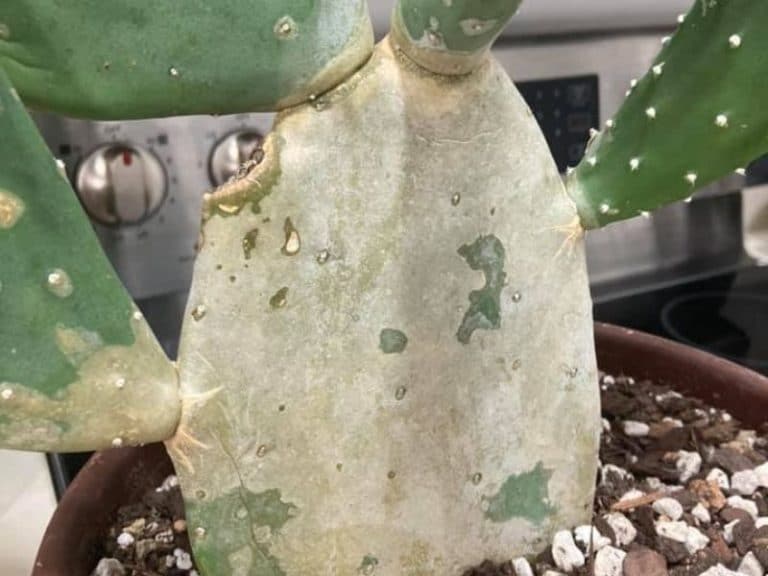Can You Eat Cactus? List of Edible & Dangerous Cacti
Cacti are fleshy and look like they can make a good vegetable. But before you eat them already, it’s important to know there are edible and poisonous cacti varieties.
Can you eat cactus?
All true cacti have edible fruit and pads. Prickly pear, cholla, saguaro, and dragon fruit cacti are safe to eat as vegetables or fruit after removing their spines. However, some cacti like peyote, Bolivian, and San Pedro cactus have psychoactive compounds and can cause hallucinations.
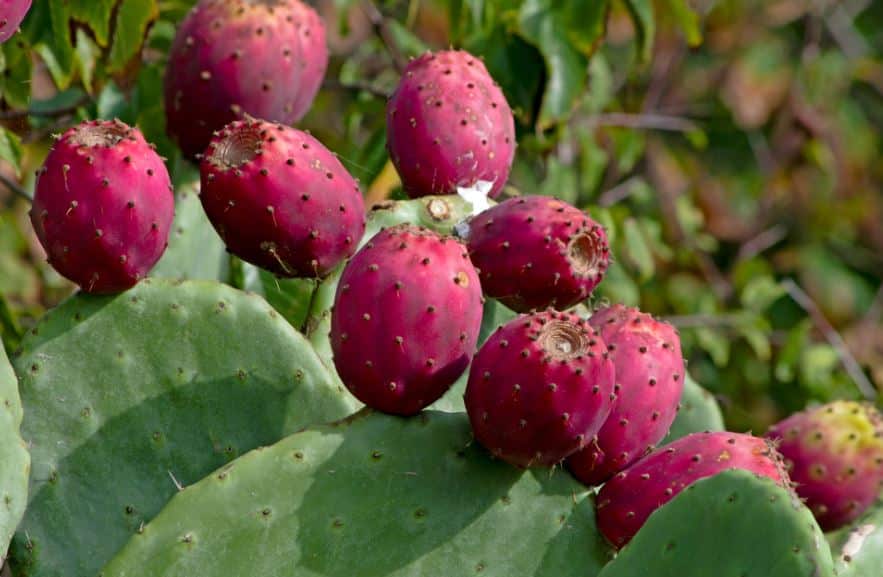
List of edible cacti
Cacti are technically edible, but not all species are generally used as food. Some cacti are used consumed ceremonially for spiritual experiences owing to their psychoactive or psychedelic effects.
Nonetheless, some cacti that are safe to eat are used as vegetables, with their pads being prepared and added to salads. Other types, such as teh saguaro cactus (Carnegiea gigantea), are consumed during religious ceremonies in some indigenous cultures like The O’odham.[1]
Here’s a list of edible cacti:
1. Prickly pear cactus (Opuntia engelmannii)
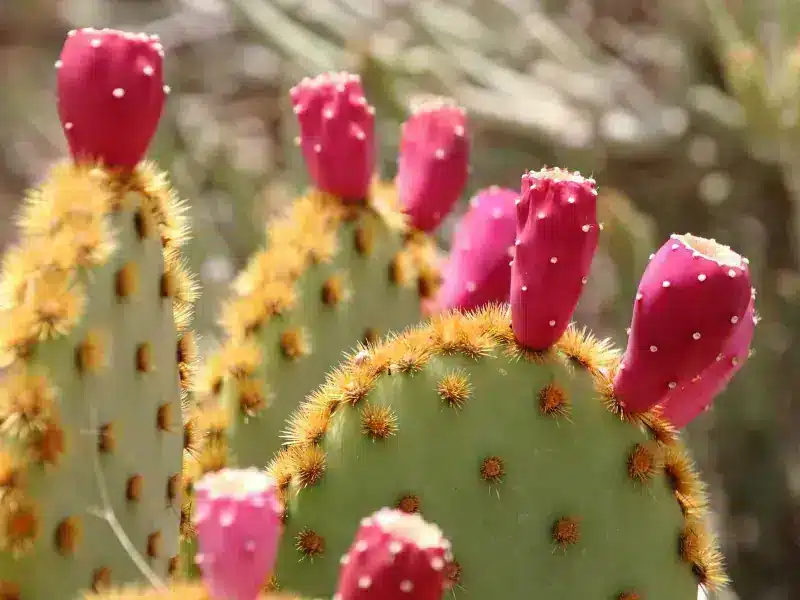
The prickly pear cactus is a type of cactus in the order Caryophyllales, Cactaceae juss family, and Opuntia genus. It is characterized by broad, flat, green pads covered in spines. This cactus is safe to eat, and is often used in stews, salads, and as a vegetable.
It is commonly eaten in Mexico, where it is called “nopales” or “sabra.” Both the pads and the fruit of prickly pear cactus are edible.
The fruits taste like melon or dragon fruit. Ripe prickly pear fruits are juicy and soft with small edible seeds. The flavor of a ripe prickly pear cactus fruit can also be compared to that of a watermelon or a kiwi.
Other people describe the taste of prickly pear cactus as Sweet and tart, melon-like, kiwi-like, bubblegum-like, earthy, or sour.
The prickly pear cactus is a good source of dietary fiber, vitamins, and minerals. According to the USDA Food Data, here are the nutritional facts of 100 grams of raw prickly pear:
| Water | 87.6 g |
| Protein | 0.73 g |
| Carbohydrates | 9.57 g |
| Dietary fiber | 3.6 g |
| Fat | 0.51 g |
| Vitamin C | 14 mg |
| Niacin | 0.46 mg |
| Iron | 0.3 mg |
| Calcium | 56 mg |
| Magnesium | 85 mg |
| Sodium | 5 mg |
Source: Prickly pear; USDA Food Data
Proper preparation of the pads before consumption is important because the prickly pear cactus contains sharp, tiny spines. Remove the prickly spines on the pads before preparing them like any vegetable, or eat them raw as part of a salad dish.
The ripe, red fruits of the prickly pear are juicy with a sweet taste. However, to access the juicy inside of the fruit, you’ll first have to remove the skin-irritating glochids and the skin itself.
2. Cholla cactus (Cylindropuntia)
Cholla is a genus of cacti (Opuntia) native to New Mexico, northern Mexico, Arizona, Kansas, Colorado, and Oklahoma. It is also called the tree cactus, cane cholla, and tuna juell.
In the spring, it produces reddish-purple flowers that develop into bright yellow or bright yellow fruits. Chollas are characterized by their cylindrical stems that are segmented into joints.
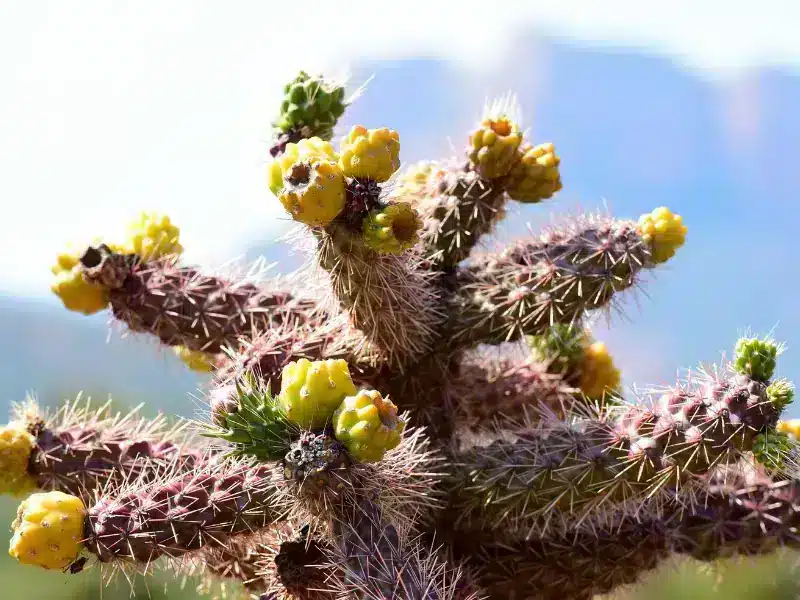
Cholla buds and fruits are edible, but they are covered with sharp spines. Removing the spines and glochids is laborious and involves taking a stick and rolling the buds on the ground. Arizona natives are known to pit-roast cholla cactus buds before eating them. The buds can be eaten with beans or added to an antipasto salad.
The buds of the cholla cactus are safe for human consumption and contain as much calcium as an 8-oz glass of milk. Other nutritional benefits of the edible cholla cactus include dietary fiber content and the regulation of blood sugars.[2]
3. Dragon fruit cactus (Hylocereus undatus)
The dragon fruit cactus, also called pitahaya, is a climbing cactus native to Central America and, South America, and Mexico. It is largely grown as an ornamental plant due to its fragrant flowers that bloom only at night. In some cases, it is grown as an edible succulent.
Dragon fruit cactus yields large colorful fruits that are edible. The yellow dragon fruit (Selenicereus megalanthus) produces yellow-skinned fruits, while the Hylocereus undatus variety produces red-skinned fruits. The fruit’s skin is leathery but can be peeled to reveal the edible white flesh with tiny black seeds distributed throughout the flesh.
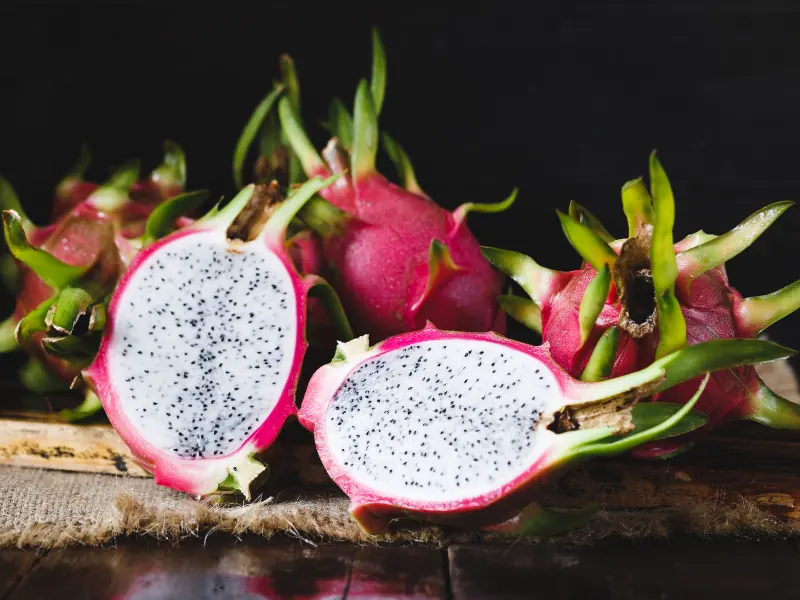
What does dragon fruit taste like?
Dragon fruit has a subtly sweet taste that resembles that of a watermelon, kiwi, or pear. The small black seeds are edible together with the fruit’s juicy flesh. Chewing the flesh with seeds brings out a texture similar to kiwi fruit.
Nutritional value
Here’s the nutritional data for dragon fruit (per 100 grams)
| Calories | 264kcal |
| Fat | 0g |
| Dietary fiber | 1.8g |
| Sugar | 82.14g |
| Calcium | 107mg |
| Vitamin C | 6.4mg |
| Sodium | 39mg |
Source: Dragon Fruit; USDA Food Data Central
Dragon fruit can be eaten raw or combined with milk, yogurt, or other fruits and blended into a smoothie. It can also be cut into small pieces to make fruit salads or make jams and desserts.
4. Barrel cactus (Ferocactus sp.)
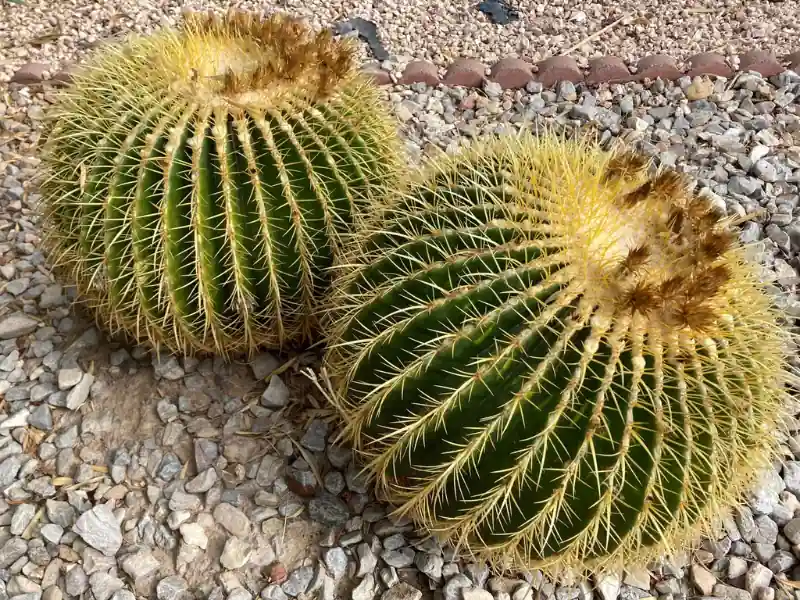
Barrel cacti belong to the Ferocactus genus and grow into a “squat tubular shape with a dense concentration of stiff spines covering and protecting the fleshy succulent. It can easily be described as a spiky barrel that produces yellow or reddish blooms depending on the variety of the cactus.
The flesh of the barrel cactus is edible and typically harvested by cutting off the top of the cactus and removing the spines and tough outer layer. Its attractive flowers develop into small fruits that are also edible. The flesh can be eaten raw or cooked in salads, stews, and other dishes.
Author note: The golden barrel cactus (Echinocactus grusonii) is classified as an endangered species and may be a protected plant in some areas.[4] Ensure you check local regulations before harvesting or consuming it.
5. Saguaro cactus (Carnegiea gigantea)
The saguaro cactus is a large and tall cactus of the Carnegiea genus. It is native to the Sonoran Desert in the southwestern United States and northwestern Mexico and grows in an upright, columnar shape with branching arms.
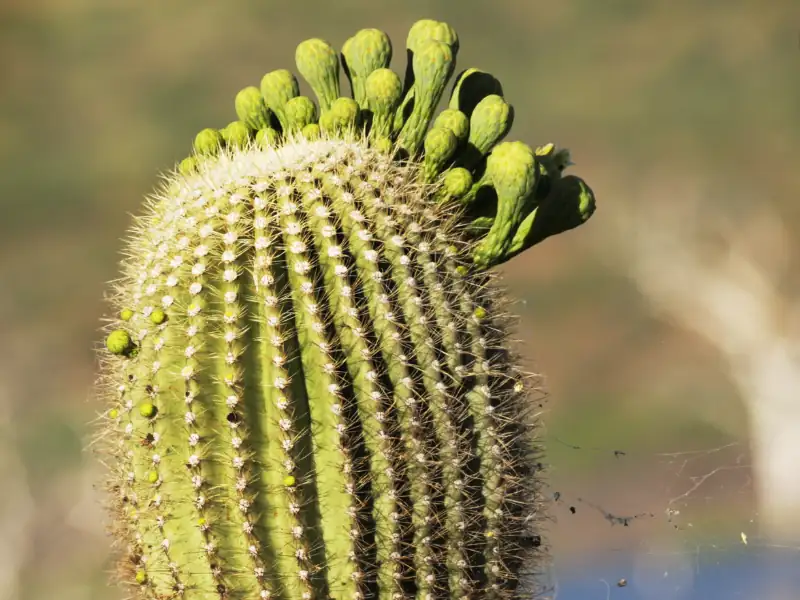
The fruit of the saguaro cactus (called the saguaro berry) is edible and has been an important food source for indigenous people in the Sonoran Desert region. Both the fruits and seeds of this cactus are edible, with the fruits having a sweet taste while the seeds taste like nuts.
The seeds of saguaro fruit are high in fats and protein and can be eaten raw or cooked. Some people grind them into flour used to make beverages.
Dangerous (Psychedelic) cacti
Many cacti are not poisonous but contain alkaloids and spines for defense. Alkaloids are the compounds that make some cacti bitter to discourage animals in their native range from eating the plants.
As already mentioned, some species of cactus are consumed as food, but there are others that are used for cultural and religious practices due to their psychedelic properties.
Psychedelic compounds have the ability to “produce hallucinations and apparent expansion of consciousness.”[5]
Here’s a list of cacti that are not used as food but have psychoactive effects:
Peyote cactus (Lophophora williamsii)
Peyote cactus contains strong alkaloids that make it extremely bitter to discourage being eaten by animals and humans. It is a non-toxic species but contains a hallucinogen called mescaline as the principal compound.
Mescaline is a compound that causes induced psychotic effects when consumed. Some of the common effects of Peyote poisoning include hallucination, agitation, nausea, and vomiting. In extreme cases, an overdose of Peyote cactus can be fatal.
According to J.D. Slothower of the Encyclopedia of Toxicology (2014), “mescaline produces an acute psychotic state after 3–4 hours…In doses of some 300–500 mg it produces visual and occasionally olfactory or auditory hallucinations, illusions, depersonalization, and anxiety depressive symptoms…Its physical effects include nausea, tremor, and sweating.” [6]
Bolivian torch (Echinopsis lageniformis)
The Bolivian Torch Cactus is another cactus variety that’s not edible because of its bitter taste and psychedelic side effects. This plant contains high amounts of mescaline and will trigger visual and auditory hallucinations when ingested.
Echinopsis zamnesiana
This cactus belongs to the Echinopsis genus and produces a strong psychoactive effect when consumed. It is columnar in shape, with spines running along its length.
Studies show that the Echinopsis zamnesiana cactus was used over two millennia ago to cast out evil spirits.[7]
San Pedro cactus
Native to the Andes Mountains, the San Pedro Cactus can cause the same psychoactive effects as Peyote cactus when ingested, as it also contains the dangerous psychedelic alkaloid – mescaline.
Common side effects of consuming San Pedro Cactus include palpitations, stomach pains, tremors, and hallucinations.
What cactus has edible fruit?
There are several cacti species whose fruits can be eaten. Here are some of the most common cacti whose fruits and seeds are edible:
- Dragon Fruit Cactus – dragon fruits have a tropical flavor, almost the same taste as watermelon. They also have a high dietary fiber content.
- Peruvian apple cactus – the fruit of the Peruvian Apple carries a sugary taste with a mild tartness. It also has a nice, crunchy texture.
- Organ pipe cactus – the fruits of this plant have a sweet flavor with a succulent texture.
- Prickly pear cactus – when raw and green, prickly pear fruits have a tropical taste. However, once they ripen and turn red-orange, they carry a sweet, sugary flavor.
- Saguaro cactus – the saguaro fruit has a subtle sweet taste, which isn’t as strong as that of prickly pear fruits.
FAQ
Is it safe to eat cactus?
Yes, many varieties of cacti are safe to eat and are considered a nutritious food source. Examples of edible cacti include prickly pear, dragon fruit, saguaro, and barrel cactus. Commonly eaten parts of cacti include fruits, pads, and flowers.
Are there cultural and historical uses of edible cacti?
Edible cacti have been used historically and culturally for food, medicine, and religious purposes. In Mexico, for example, edible cacti are a staple food used in various dishes. Some cacti are also used for spiritual awakening owing to their psychedelic properties.
References
- [6] Slothower, J.D., & Wiegand, T.J. (2014). Mescaline. In P. Wexler (Ed.), Encyclopedia of Toxicology (Third Edition) (pp. 221-222). Academic Press. ISBN 9780123864550. https://doi.org/10.1016/B978-0-12-386454-3.00747-8.


